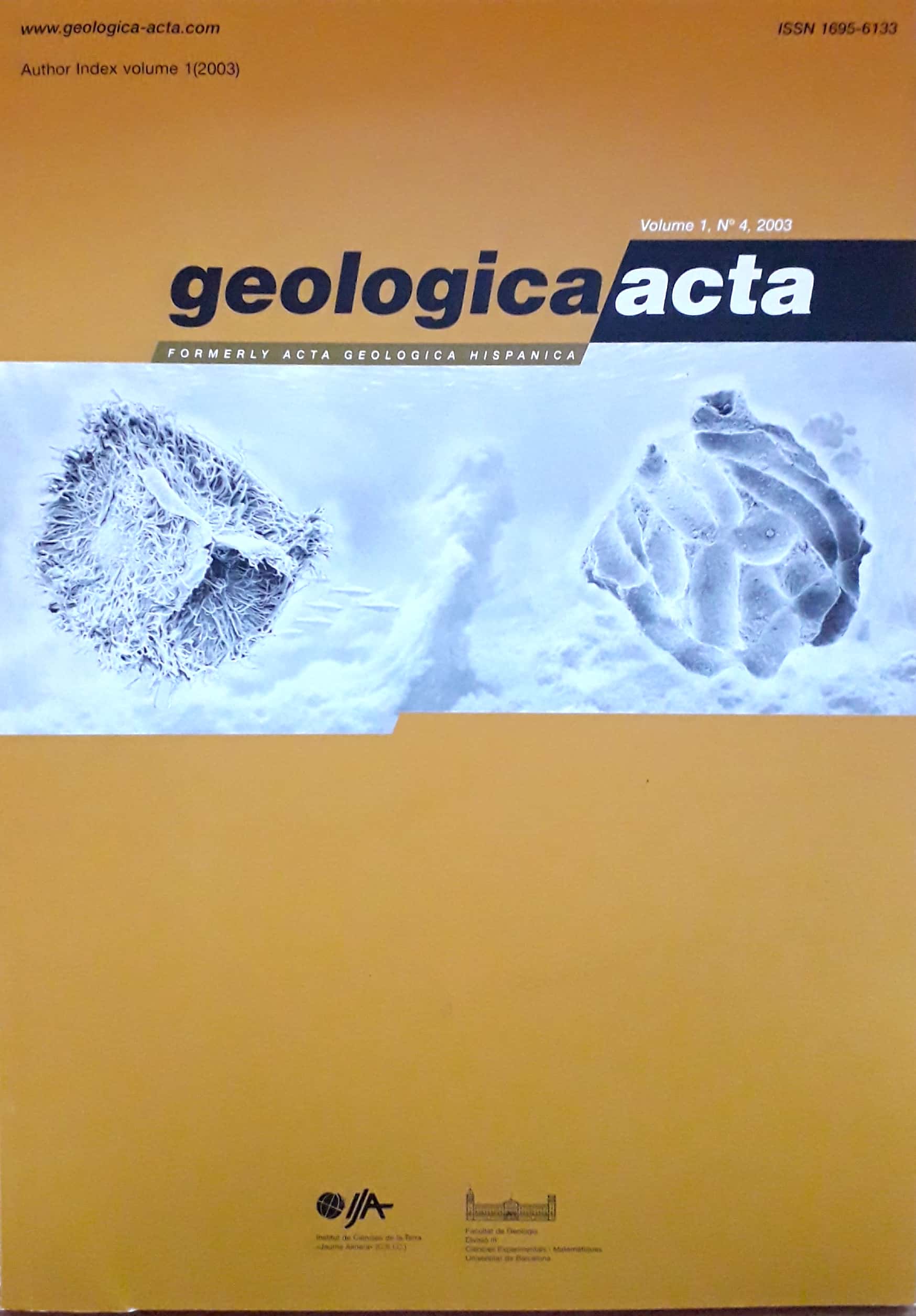Role of fluid mixing in deep dissolution of carbonates
DOI:
https://doi.org/10.1344/105.000001618Keywords:
Hydrothermal karst, MVT deposits, Reactive transport, Fluid mixing, Carbonate dissolutionAbstract
The presence of cavities filled with new minerals in carbonate rocks is a common feature in oil reservoirs and lead-zinc deposits. Since groundwater equilibrates rapidly with carbonates, the presence of dissolution cavities in deep carbonate host rocks is a paradox. Two alternative geochemical processes have been proposed to dissolve carbonates at depth: hydrogen sulfide oxidation to sulfuric acid, and metal sulfide precipitation. With the aid of geochemical modeling we show that mixing two warm solutions saturated with carbonate results in a new solution that dissolves limestone. Variations in the proportion of the end-member fluids can also form a supersaturated mixture and fill the cavity with a new generation of carbonate. Mixing is in general more effective in dissolving carbonates than the aforementioned processes. Moreover, mixing is consistent with the wide set of textures and mineral proportions observed in cavity infillings.
References
Anderson, G.M., 1973. The hydrothermal transport and deposition of galena and sphalerite near 100ºC. Economic Geology, 68, 480-492.
Anderson, G.M., 1975. Precipitation of Mississippi Valley-type ores. Economic Geology, 70, 937-942.
Anderson, G.M., Garven, G., 1987. Sulfate-sulfide-carbonate association in MVT Pb-Zn deposits. Economic Geology, 82, 482-488.
Appold, M.S., Garven, G., 2000. Reactive flow models of ore formation in the Southeast Missouri District. Economic Geology, 95, 1605-1626.
Ayora, C., Taberner, C., Saaltink, M.W., Carrera, J., 1998. The genesis of dedolomites: a discussion based on textures and reactive transport modeling. Journal of Hydrology, 209, 346-365.
Back, W., Hanshaw, B.B., 1971. Rates of physical and chemical processes in a carbonate aquifers. In: Nonequilibrium systems in natural water chemistry. Advances in Chemistry Series, 106, 77-93.
Back, W., Hanshaw, B.B., Pyle, T.E., Plummer, L.N., Weidie, A.E., 1979. Geochemical significance of groundwater discharge and carbonate solution to the formation of Caleta Xel Ha, Quintana Roo, Mexico. Water Resources Research, 15, 1521-1535.
Barnes, H.L., 1983. Ore depositing reactions in Mississippi Valley-type deposits. In: Kisvarsanyi, G., Grant, S.K, Pratt, W.P., Koenig, J.W. (eds.). International Conference on Mississippi Valley Type Lead-Zinc Deposits. Rolla, University of Missouri-Rolla Press, Proceedings. 77-85.
Deike, R.G., 1990. Dolomite dissolution rates and possible Holocene dedolomitization of water-bearing units in the Edwards aquifer, South-Central Texas. Journal of Hydrology, 112, 335-373.
Dunham, K., 1983. Ore genesis in the English Pennines: a fluoritic subtype. In: Kisvarsanyi, G., Grant, S.K., Pratt, W.P., Koenig, J.W. (eds.). International Conference on Mississippi Valley Type Lead-Zinc Deposits. Rolla, University of Missouri-Rolla Press, Proceedings, 86-112.
Garven, G., Freeze, R.A., 1984. Theoretical analysis of the role of groundwater flow in the genesis of stratabound ore deposits. 2. Quantitative results. American Journal of Science, 284, 1125-1174.
Giordano, T.H., Barnes, H.L., 1981. Lead transport in Mississippi Valley-Type ore solutions. Economic Geology, 76, 2200-2211.
Grenthe, W., Stumm, M., Laaksoharju, A.C., Nilson, P., Wikberg, P., 1992. Redox potentials and redox reactions in deep groundwater systems. Chemical Geology, 98, 131-150.
Hanor J.S., 2001. Reactive transport involving rock-buffered fluids of varying salinity. Geochimica et Cosmochimica Acta, 65, 3721-3732.
Hayashi, K., Sugaki, A., Kitakaze, A., 1990. Solubility of sphalerite in aqueous sulfide solutions at temperatures between 25 and 240ºC. Geochimica et Cosmochimica Acta, 54, 715-725.
Helgeson H.L., Kirkham, D.H., 1974. Theoretical prediction of the thermodynamic behavior of aqueous electrolytes at high pressures and temperatures. II: Debye-Hückel parameters for activity coefficients and relative partial molal properties. American Journal of Science, 274, 1199-1261.
Heyl, A.V., Agnew, A.F., Lyons, E.J., Behre, C.H., 1959. The Geology of the Upper Mississippi Valley zinc-lead district. United States Geological Survey Professional Paper no. 309, 310 pp.
Hill, C.A., 1990. Sulfuric acid speleogenesis of Carlsbad Cavern and its relationship to hydrocarbons, Delaware Basin, New Mexico and Texas. American Association of Petroleum Geologists Bulletin, 74, 1685-1694.
Hill, C.A., 1995. H2S-related porosity and sulfuric acid oil-field karst. In: Budd, D.A., Saller, A.H., Harris, P.M. (eds.). Unconformities and porosity in carbonate strata. American Association of Petroleum Geologists, Memoir 63.
Hitzman, M.W., Beaty, D.W., 1996. The Irish Zn-Pb-(Ba) orefield. In: Sangster, D.F. (ed.). Carbonate-Hosted lead-Zinc Deposits. Society of Economic Geologists Special Publication, 4, 112-143.
Jackson, S.A., Beales, F.W., 1967. An aspect of sedimentary basin evolution: the concentration of Mississippi Valley-type ores during late stages of diagenesis. Bulletin of Canadian Petroleum Geology, 15, 383-433.
Kesler, S.E., 1996. Appalachian Mississippi Valley-type deposits: Paleoaquifers and brine provinces. In: Sangster, D.F. (ed.). Carbonate-Hosted lead-Zinc Deposits. Society of Economic Geologists Special Publication, 4, 29-57.
Leach, D.L., Viets, J.G., Kozlowski, A., Kibitlewski S., 1996. Geology, geochemistry, and genesis of the Silesia-Cracow zinc-lead district, southern Poland. In: Sangster, D.F. (ed.). Carbonate-Hosted lead-Zinc Deposits. Society of Economic Geologists Special Publication, 4, 144-170.
Lu, J., Craig, J.R., Rimstidt, J.D., 1995. Paragenesis and geochemistry of the Idol Mine zinc deposit, Tennessee. Economic Geology, 90, 194-199.
McLimans, R.K., 1977. Geological, fluid inclusions, and stable isotopes studies of the Upper Mississippi Valley zinc-lead district, southwest Wisconsin. Doctoral thesis. Penn State University. 175 pp.
Mogollón, J.L., García, B., Hernández, C., 1999. Validation and application of physical and numerical methods for scaling predictions. Visión Tecnológica, 6, 101-112.
Nield, D.A., Bejan, A., 1992. Convection in porous media. New York, Springer-Verlag, 402 pp.
Ohmoto, H., Lasaga, A.C., 1982. Kinetics of reactions between aqueous sulfates and sulfides in hydrotermal systems. Geochimica et Cosmochimica Acta, 46, 1727-1745.
Plumlee, G.S., Leach, D.L., Hofstra, A.H., Landis, G.P., Rowan, E.L., Viets, J.G., 1994. Chemical reaction path modeling of ore deposition in Mississippi Valley-type Pb-Zn deposits of the Ozark region, U.S. mid-continent. Economic Geology, 89, 1361-1383.
Randell, R.N., Anderson, G.M., 1996. Geology of the Polaris ZnPb deposit and surrounding area, Canadian Arctic Archipelago. In: Sangster, D.F. (ed.). Carbonate-Hosted lead-Zinc Deposits. Society of Economic Geologists Special Publication, 4, 307-319.
Raup, O.B., 1970. Brine mixing: an additional mechanism of formation of basin evaporates. American Association of Petroleum Geologists, 12, 2246-2259.
Sandford, W.E., Konikow, L.F., 1989. Simulation of calcite dissolution and porosity changes in saltwater mixing zones in coastal aquifers. Water Resources Research, 25, 655-667.
Sass-Gustkiewicz, M., Dzulynski, S., Ridge, J.D., 1982. The emplacement of zinc-lead sulfide ores in the Upper Silesian district – a contribution to the understanding of Mississippi Valley-type deposits. Economic Geology, 77, 392-412.
Schroll, E., 1996. The Triassic carbonate-hosted Pb-Zn mineralization in the Alps (Europe): The genetic position of Bleiberg type deposits. In: Sangster, D.F. (ed.). CarbonateHosted lead-Zinc Deposits. Society of Economic Geologists Special Publication, 4, 182-194.
Sverjensky, D.A., 1986. Genesis of Mississippi Valley-type leadzinc deposits. Annual Reviews of Earth and Planetary Sciences, 14, 177-199.
Sverjensky, D.A., 1987. The role of migrating oil field brines in the formation of sediment-hosted Cu-rich deposits. Economic Geology, 82, 1130-1141.
Wicks, C.M., Herman, J.S., 1996. Regional hydrogeochemistry of a modern coastal mixing zone. Water Resources Research, 32, 401-407.
Wigley, T.M., Plummer, L.N., 1976. Mixing of carbonate waters. Geochimica et Cosmochimica Acta, 40, 989-995.
Wolery, T.J., 1992. EQ3NR, a computer program for geochemical aqueous speciation-solubility calculations: Theoretical manual, user’s guide and related documentation (Version 7.0). Publication UCRL-MA-110662 Pt III, Lawrence Livermore Laboratory, Livermore, California, USA.
Downloads
Published
Issue
Section
License

This work is licensed under a Creative Commons Attribution-ShareAlike 4.0 International License.
Copyright
Geologica Acta is the property of the UB, GEO3BCN, IDAEA and UAB. Geologica Acta must be cited for any partial or full reproduction. Papers are distributed under the Attribution-Share Alike Creative Commons License. This license allows anyone to reproduce and disseminate the content of the journal and even make derivative works crediting authorship and provenance and distributing possible derivative works under the same or an equivalent license.
Author Rights
Authors retain the copyright on their papers and are authorized to post them on their own web pages or institutional repositories. The copyright was retained by the journal from the year 2003 until 2009. In all cases, the complete citation and a link to the Digital Object Identifier (DOI) of the article must be included.
The authors can use excerpts or reproduce illustrations of their papers in other works without prior permission from Geologica Acta provided the source of the paper including the complete citation is fully acknowledged.




